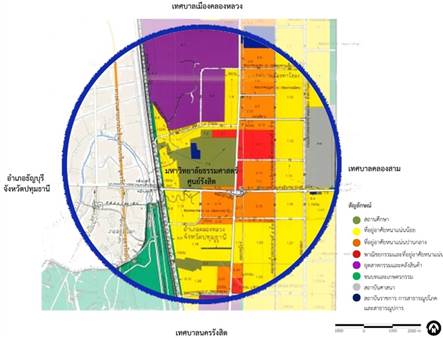Sustaining Road Safety for Campus Town Development: Case Study of Thammasat University (Rangsit Campus)
Main Article Content
Abstract
Thammasat University (Rangsit Campus) is located in Pathumthani province, one of Bangkok vicinities that perform as the capital of governing and development. Such a location is surrounded by industrial development area and transportation corridor playing a key role in generating the demand for transportation which causes serious traffic problems, particularly the mix of heavy trucks and other modes of transportation. Furthermore, poor physical plan and unconnectedness between zones have made the university a motorized campus. Staff and students use individual cars rather than walking and cycling. Therefore, this study aimed to explore the characteristics of physical environment of the campus and its surrounding that affect travelling behavior and preferences of campus users. The face to face interview, the 300 sets of questionnaire and statistical analysis were conducted. Spatial analysis was also carried out. This was to examine the safety in the campus. Importantly, guidelines to enhance road safety through public involvement and the principles of green sustainable university would be described.
Downloads
Article Details

This work is licensed under a Creative Commons Attribution-NonCommercial-NoDerivatives 4.0 International License.
All material is licensed under the terms of the Creative Commons Attribution 4.0 International (CC-BY-NC-ND 4.0) License, unless otherwise stated. As such, authors are free to share, copy, and redistribute the material in any medium or format. The authors must give appropriate credit, provide a link to the license, and indicate if changes were made. The authors may do so in any reasonable manner, but not in any way that suggests the licensor endorses you or your use. The authors may not use the material for commercial purposes. If the authors remix, transform, or build upon the material, they may not distribute the modified material, unless permission is obtained from JARS. Final, accepted versions of the paper may be posted on third party repositories, provided appropriate acknowledgement to the original source is clearly noted.
References
Abu-Ghazzeh, T. M. (1999). Communicating behavioral research to campus design factors affecting the perception and use of outdoor spaces at the University of Jordan. Environment and behavior, 31(6), 764-804.
Alshuwaikhat, H. M., & Abubakar, I. (2008). An integrated approach to achieving campus sustainability: assessment of the current campus environmental management practices. Journal of Cleaner Production, 16(16), 1777-1785. Reterived from http://www.wildcenter.org/adkyouthsummit-org/wp-content/uploads/2011/10/Achieving-Campus-Sustainability-Alshuwaikhat-and-Abubakar.pdf.
Balsas, C. J. L. (2002). New directions for bicycle and pedestrian planning education in the US. Planning Practice and Research, 17(1), 91-105.
Barton, H., Grant, M., & Guise, R. (2010). Review of ‘Shaping neighbourhoods for local health and global sustainability’. Journal of Public Health, 32(4), 27. DOI: 10.1093/pubmed/fdq077.
Blomberg, S. P., Garland, T., & Ives, A. R. (2003). Testing for phylogenetic signal in comparative data: Behavioral traits are more labile. Evolution, 57(4), 717–745.
Boonkham, D. (2006). Campus development plan. Reterived from http://www.dent.psu.ac.th/mind/lecturer/Decha/%C3%C7%D2%A7%BC%D1%A7%C7%D4%B7%C2%D2%E0%A2%B5-%C1%CD.pdf.
Boyet, W. E., & Tolley, G. S. (1966). Recreation projection based on demand analysis. Journal of Farm Economics, 48(4), 984-1001.
Carmona, M., Heath, T., Oc. T., & Tiesdell, S. (2010). Public places urban spaces: The dimensions of urban design. UK: Routledge publishing.
Croog, R. (2016). Campus sustainability at the edges: Emotions, relations, and bio-cultural connections. Geoforum, 74, 108-116. Retrieved from http://ac.els-cdn.com/S0016718516300173/1-s2.0-S0016718516300173-main.pdf?_tid=0a8b79d2-5c97-11e7-9920-00000aacb360&acdnat=1498719124_31e292594289eee328fb6ce9b9436f2a.
Department of Land Transport. (2016). Strategic plan, Department of Land Transport 2016-2020. Retrieved from https://www.dlt.go.th/th/public-news/view.php?_did=1008.
Iamtrakul, P., & Raungratanaamporn, I. (2015). Sustainable campus town development in suburban area of Bangkok, Thailand. International Journal of Building, Urban, Interior and Landscape Technology (BUILT), 6, 39-51.
Iamtrakul, P., Raungratanaamporn, I., & Shinpiriya, P. (2017a). Framework of planning and policy analysis for Transit Oriented Development (TOD) towards sustainable Urban Development. Journal of Architectural/Planning and studies (JARS), 14(1), 95-122.
Iamtrakul P., Srivanit, M., & Klaylee J. (2017b). The study on promoting hybrid canal-rail connectivity in Bangkok and its vicinity. International Journal of Building, Urban, Interior and Landscape Technology (BUILT), 10, 27-41.
Marcus, C. C., & Francis, C. (1998). People place, Design guidelines for urban open space (2nd ed.). New York, USA.: John Wiley and Sons.
Pimonsathean, Y. (2000). Theory of implementation for urban planning. Proceeding of the 1st Urban and Regional Planning Academic Symposium [URPAS] on January 24, 2000, pp. 104-119. Bangkok, Thailand: Department of Urban and Regional Planning, Chulalongkorn University.
Pittungnapoo, W. (2012). Management of urban environments, Universities and community participation, Case study of Klong Nong steel community, Naresuan University (Research report). Phitsanulok, Thailand: Naresuan University.
Pondej, C., Suphathida, S., & Methee, P. (2016). Participatory action research in promoting safe bike to school. Journal of Architectural/Planning and studies (JARS), 13(2), pp. 69-84.
Taneerananon, P. (2006). Engineering safety road. Songkhla, Thailand: Lim Brader Printing.
Tolley, R. (1996). Green campuses: cutting the environmental cost of commuting. Journal of Transport Geography, 4(3), 213-217.
Yang, H. (2007). Campus landscape space planning and design using quality function deployment. Reterived from http://scholar.lib.vt.edu/theses/available/etd-06262007-211426/unrestricted/content.pdf.

